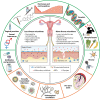The Complex Link between the Female Genital Microbiota, Genital Infections, and Inflammation
- PMID: 33558324
- PMCID: PMC8091093
- DOI: 10.1128/IAI.00487-20
The Complex Link between the Female Genital Microbiota, Genital Infections, and Inflammation
Abstract
The female genital tract microbiota is part of a complex ecosystem influenced by several physiological, genetic, and behavioral factors. It is uniquely linked to a woman's mucosal immunity and plays a critical role in the regulation of genital inflammation. A vaginal microbiota characterized by a high abundance of lactobacilli and low overall bacterial diversity is associated with lower inflammation. On the other hand, a more diverse microbiota is linked to high mucosal inflammation levels, a compromised genital epithelial barrier, and an increased risk of sexually transmitted infections and other conditions. Several bacterial taxa such as Gardnerella spp., Prevotella spp., Sneathia spp., and Atopobium spp. are well known to have adverse effects; however, the definitive cause of this microbial dysbiosis is yet to be fully elucidated. The aim of this review is to discuss the multiple ways in which the microbiota influences the overall genital inflammatory milieu and to explore the causes and consequences of this inflammatory response. While there is abundant evidence linking a diverse genital microbiota to elevated inflammation, understanding the risk factors and mechanisms through which it affects genital health is essential. A robust appreciation of these factors is important for identifying effective prevention and treatment strategies.
Keywords: cytokines; female genital tract; immune response; inflammation; vaginal microbiota.
Copyright © 2021 American Society for Microbiology.
Figures

References
-
- Anahtar MN, Byrne EH, Doherty KE, Bowman BA, Yamamoto HS, Soumillon M, Padavattan N, Ismail N, Moodley A, Sabatini ME, Ghebremichael MS, Nusbaum C, Huttenhower C, Virgin HW, Ndung’u T, Dong KL, Walker BD, Fichorova RN, Kwon DS. 2015. Cervicovaginal bacteria are a major modulator of host inflammatory responses in the female genital tract. Immunity 42:965–976. 10.1016/j.immuni.2015.04.019. - DOI - PMC - PubMed
-
- Lennard K, Dabee S, Barnabas SL, Havyarimana E, Blakney A, Jaumdally SZ, Botha G, Mkhize NN, Bekker L-G, Lewis DA, Gray G, Mulder N, Passmore J-AS, Jaspan HB. 2018. Microbial composition predicts genital tract inflammation and persistent bacterial vaginosis in South African adolescent females. Infect Immun 86:e00410-17. 10.1128/IAI.00410-17. - DOI - PMC - PubMed
-
- McKinnon LR, Achilles SL, Bradshaw CS, Burgener A, Crucitti T, Fredricks DN, Jaspan HB, Kaul R, Kaushic C, Klatt N, Kwon DS, Marrazzo JM, Masson L, McClelland RS, Ravel J, van de Wijgert JHHM, Vodstrcil LA, Tachedjian G. 2019. The evolving facets of bacterial vaginosis: implications for HIV transmission. AIDS Res Hum Retroviruses 35:219–228. 10.1089/AID.2018.0304. - DOI - PMC - PubMed
Publication types
MeSH terms
Grants and funding
LinkOut - more resources
Full Text Sources
Other Literature Sources
Miscellaneous

